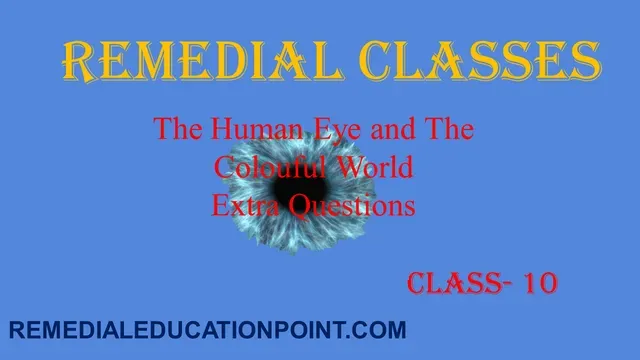In this article, you will find Class 10 Science Chapter 11 Extra Questions
Physics. In Class
10 Science Chapter 11 Extra Questions, you will find extra questions
for better practice that will help you in your board exams. These extra questions are based on NCERT Solutions of Chapter 11 for class 10 science that is very useful for you.
Class 10 Science Chapter 11 Extra Questions
Class 10 Science
Chapter 11 Extra Questions consist topics- human eye, working of the human eye,
clear vision, accommodation, near point and far point, defects of vision- Myopia, Hypermetropia, presbyopia,
Astigmatism, Colour blindness, Cataract, Refraction of light through a glass
prism, dispersion of light, spectrum, a combination of white light, Rainbow formation, various incidents of atmospheric
refraction etc.
 |
| Class 10 Science Chapter 11 Extra Questions |
If you find any difficulty in finding answers to Class 10 Science Chapter 11 Extra Questions then go through NCERT solutions of class 10 science or you can comment in the comment section, we will be very pleased to help you.
Class 10 Science Chapter 11 Extra Questions
CHAPTER- 11-THE HUMAN EYE AND THE COLOURFUL WORLD
1. Draw the labelled diagram of the human eye and
describe its structure and work?
2. What do you understand by the power of
accommodation?
3. What is the function of the iris in the human eye?
4. What is aqueous humour?
5. What is the diameter of the eyeball?
6. Name the parts of the human eye which -
i. Involved in the transmission of light
ii. Responsible for conversion of light to an electrical impulse.
iii. transmits the impulses to the brain
7. What is the main cause of the malfunctioning of an eye?
8. What is a cataract? How is it corrected?
9. What do you mean by defective eye?
10. Why do we have two eyes for vision?
11. Describe the main defects of the eye with symptom,
cause and correction with diagram. Draw the diagram also.
12. A person with a myopic eye cannot see objects
beyond 1.2m distinctly. What should be the type of corrective lens used to
restore proper vision?
13. What is a bifocal lens?
14. Write the conditions for eye donation.
15. What do you mean by the angle of the prism?
16. What is the angle of deviation?
17. Why do we get different colours when light
passes through a prism?
18. Which colour bends least and which one bends
most?
19. What is the sequence of seven colours in a
spectrum?
20. Describe Newton’s experiment showing that
sunlight is made of seven colours. Draw the diagram also.
21. What is a cataract? How is it corrected?
22. What is the far point and near the point of the
human eye with normal vision?
23. A student has difficulty reading the
blackboard while sitting in the last row. What could be the defect the child
is suffering from? How can it be corrected?
24. What is the dispersion f white light?
25. What is spectrum?
26. (i). what is Tyndall effect
(ii). Why is the colour of the clear sky
blue?[Annual exam- 2012]
27. Draw the ray diagram for a myopic and hypermetropic eye. Write the least distance of distinct vision.[Annual exam-
2012]
28. Why is hypermetropia caused? How can it be
corrected?[Annual exam]
29. Define prism angle and angle of deviation for
a prism. Write the sequence of colours in the spectrum formed by the passage of
white light through a prism. Explain the formation of the rainbow.[Annual exam- 2013]
30. What do you mean by white light?
31. Draw the diagram of the refraction of light
through a prism.
32. How many corneal blind people can get a vision
from one pair of eyes?
33. What phenomena cause the formation of a rainbow?
34. What is the dispersion of light?
35. Give some phenomena caused by atmospheric
refraction.
36. In which medium does the atmospheric refraction
occur?
37. Why is the normal eye not able to see clearly the
objects placed closer than 25cm?
38. Name the part of the human eye which control the
amount of light entering the eye.
39. Why does the sun appear reddish early in the
morning or in the evening?
40. Why does the sky appear dark instead of blue
to an astronaut or pilot of an aircraft?
41. Describe the formation of a rainbow in the sky?
42. What does VIBGYOR represent?
43. What is scattering of light?
44. Why do stars look twinkling?
45. Name the phenomena which cause the twinkling of stars.
46. What is the reason for advanced sunrise and
delayed sunset?
47. What is the Tyndall effect?
48. Which phenomenon is responsible for increasing
the apparent length of the day by 4 minutes?
49. Why do the planets not twinkle?
50. Why is the colour of the sky blue?
51. Describe the activity that shows the colour
of the sun at sunrise and sunset?
52. Which colour has the largest wavelength?
.webp)



No comments:
Post a Comment